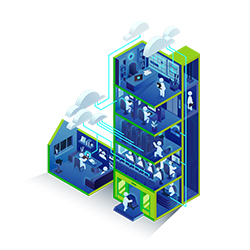Author: Mahdy Ghane
Solution Architect, Data & Dynamics
Long View
Microsoft Fabric: Data Intelligence Across Domains
Long View is committed to moving our clients forward with solutions that drive efficiency, innovation, and security. One such solution is Microsoft Fabric, a robust platform that can enhance your data management and analytics processes. Microsoft Fabric offers a unified approach to data intelligence, enabling organizations to seamlessly manage, analyze, and gain insights from their data across various domains, ensuring they keep up to date.
To learn more about how Microsoft Fabric can enhance data and analytics across your organization, watch the free webinar hosted by Long View here.
What is Microsoft Fabric?
Microsoft Fabric is a comprehensive platform integrating various data analytics tools into a cohesive system. While Power BI is a powerful tool for business intelligence, it often requires multiple additional tools to handle diverse data analytics needs. Microsoft Fabric eliminates this complexity by providing a unified solution that takes away the heavy lifting of managing and integrating multiple toolsets.
Let’s dive into some of the ways Microsoft Fabric can help your organization achieve maximum efficiency.
Simplified Data Management and Integrated Tools
By combining data integration, data engineering, data warehousing, data science, real-time analytics, and business intelligence into one platform, Microsoft Fabric offers a seamless experience for organizations looking to leverage their data fully. It eliminates the need for setting up complex environments and hardware. This integration ensures that all data processes, from ingestion to visualization, are streamlined, reducing the time and effort required to achieve actionable insights, and freeing up time for your team to focus on innovation.
Enhanced Data Integration and Real-Time Analytics
Microsoft Fabric enables efficient data ingestion and storage with OneLake, a national storage layer that simplifies data operations. By storing all data in Delta Parquet files within OneLake, you can expect a seamless experience that simplifies your data operations and empowers you to deliver more value to your customers.
Enriched Collaboration and Efficiency
Collaboration is key to innovation, and Microsoft Fabric excels in this area. The platform breaks down data silos, providing a unified environment where teams can access and process data collaboratively. This promotes democratization of data, enabling better decision-making, accelerating project timelines, and making organizations more agile and responsive to market demands. Furthermore, advanced access control features ensure that only authorized personnel can access sensitive data, enhancing your organization’s security posture and ensuring compliance with regulatory requirements.
For insights into a Microsoft OneLake folder structure and how you can organize workspaces, don’t forget to watch the breakdown by our in-house Data & AI expert, Caelon Voogt.
Improved Compatibility and Flexibility
Microsoft Fabric’s compatibility with existing tools like Azure DevOps and Azure Data Factory means you don’t need to overhaul your current systems. A key component of Microsoft Fabric is its One Security Model, which streamlines data handling and enhances role-based access. This model provides a cohesive and controlled data environment, simplifying the process of setting up security rules. With One Security Model, organizations can ensure robust data protection and compliance without the complexity typically associated with managing security across multiple systems.
Integrated Fabric and AI Functionality
When it comes to the intersection of Fabric and AI, particularly in the realm of data science, the platform stands out as a catalyst for innovation and efficiency. Fabric provides data scientists with direct access to a centralized data environment, where they can conduct experiments, develop models, and deploy them with unprecedented ease. This seamless integration means that data scientists can work with the latest data without the need for cumbersome data transfers or conversions. With tools like Fabric Copilot, users can receive recommendations and code snippets to streamline their data modeling and tasks, whether it's data ingestion or complex ETL processes.
Unified Microsoft Fabric Architecture
Microsoft Fabric is a fully contained solution that can be used both as a standalone platform and in combination with third-party solutions. Its architecture is designed to support the entire data lifecycle, from ingestion to reporting. With Fabric, data can be ingested from various sources, processed and stored within workspaces, and seamlessly integrated into your reporting tools. This advanced architecture ensures that all components work together harmoniously, providing a streamlined and efficient data management experience.
Watch the full webinar for a detailed demonstration of how Microsoft Fabric works across the entire data lifecycle, from data ingestion sources to data organization in workspaces, and reporting.
Advanced Data Mirroring and Capabilities
Data mirroring is a key capability of Fabric, offering a read replica option that synchronizes data across environments without recreating the entire environment on the other side. This feature utilizes Delta Parquet files and an Azure-managed SQL instance to mirror data, ensuring that it is available in the Fabric environment with minimal setup and management costs. With this capability, Fabric makes a mark as a cost-effective solution that allows for real-time loads and minimal impact on servers, providing flexibility in building and managing the data environment.
Enhanced Control and Custom Frameworks
Fabric administrators play a crucial role in managing the environment, ensuring optimal performance and efficient resource utilization. By defining sensitivity labels, administrators can help maintain data security throughout its lifecycle, ensuring only authorized users can access sensitive information.
Microsoft Fabric includes custom frameworks that adapt to new features and functionalities, ensuring you always have access to the latest advancements. This continuous improvement helps your organization stay ahead of the curve and leverage the full potential of Fabric.
Ready to Integrate Microsoft Fabric?
If you missed our webinar or have further questions, don’t hesitate to reach out to our team. We’ll guide you through every step of your journey with Microsoft Fabric, whether migrating existing data warehouses or setting up new environments, ensuring you achieve the best possible outcomes.
Stay tuned for more webinars and updates from Long View as we continue to bring you the latest in technology and innovation.

Subscribe to our newsletter for the latest updates.